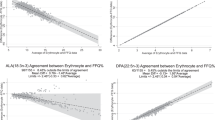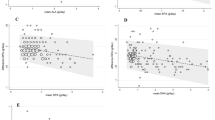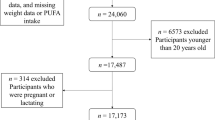Abstract
Objective:
We conducted a dietary validation study in youth aged 1–11 years by comparing dietary intake of omega-3 and omega-6 polyunsaturated fatty acids (PUFAs) as assessed by a parent-completed semiquantitative food frequency questionnaire (FFQ) over time to erythrocyte membrane composition of the same fatty acids.
Design:
The study population included youth aged 1–11 years who were participants in the Diabetes Autoimmunity Study in the Young (DAISY), a longitudinal study in Denver, Colorado that is following a cohort of youth at risk for developing type I diabetes. Four hundred and four children who had erythrocyte membrane fatty acid data matched to an FFQ corresponding to the same time frame for a total of 917 visits (matches) were included. PUFA intake was expressed both as g/day (adjusted for total energy) and as percent of total fat intake. We used mixed models to test the association and calculate the correlation between the erythrocyte membrane estimates and PUFA intake using all records of data for each youth.
Results:
Intakes of total omega-3 fatty acids (β=0.52, P<0.0001, ρ=0.23) and marine PUFAs (β=1.62, P<0.0001, ρ=0.42), as a percent of total fat in the diet, were associated with percent of omega-3 and marine PUFAs in the erythrocyte membrane. Intakes of omega-6 PUFAs (β=0.04, P=0.418, ρ=0.05) and arachidonic acid (β=0.31, P=0.774, ρ=0.01) were not associated.
Conclusions:
In these young children, an FFQ using parental report provided estimates of average long-term intakes of marine PUFAs that correlated well with their erythrocyte cell membrane fatty acid status.
This is a preview of subscription content, access via your institution
Access options
Subscribe to this journal
Receive 12 print issues and online access
$259.00 per year
only $21.58 per issue
Buy this article
- Purchase on Springer Link
- Instant access to full article PDF
Prices may be subject to local taxes which are calculated during checkout
Similar content being viewed by others
References
Agricultural Research Service (1995). USDA Nutrient Database for Standard Reference. Department of Agriculture: Washington, DC.
Arab L (2003). Biomarkers of fat and fatty acid intake. J Nutr 133 (Suppl 3), 925S–932S.
Baur L, O'Connor J, Pan D, Wu B, O'Connor M, Storlien L (2000). Relationships between the fatty acid composition of muscle and erythrocyte membrane phospholipid in young children and the effect of type of infant feeding. Lipids 35, 77–82.
Bezard J, Blond JP, Bernard A, Clouet P (1994). The metabolism and availability of essential fatty acids in animal and human tissues. Reprod Nutr Dev 34, 539–568.
Bingham SA, Day NE (1997). Using biochemical markers to assess the validity of prospective dietary assessment methods and the effect of energy adjustment. Am J Clin Nutr 65 (Suppl 4), 1130S–1137S.
Bligh E, Dyer W (1959). A rapid method of total lipid extraction and purification. Can J Biochem Physiol 37, 911–917.
Cantwell MM, Gibney MJ, Cronin D, Younger KM, O'Neill JP, Hogan L et al. (2005). Development and validation of a food-frequency questionnaire for the determination of detailed fatty acid intakes. Public Health Nutr 8, 97–107.
Decsi T, Boehm G, Tjoonk HMR, Molnar S, Dijck-Brouwer DAJ, Hadders-Algra M et al. (2002). Trans isomeric octadecenoic acids are related inversely to arachidonic acid and DHA and positively related to mead acid in umbilical vessel wall lipids. Lipids 37, 959–965.
Feunekes GI, Van Staveren WA, De Vries JH, Burema J, Hautvast JG (1993). Relative and biomarker-based validity of a food-frequency questionnaire estimating intake of fats and cholesterol. Am J Clin Nutr 58, 489–496.
Glatz JF, Soffers AE, Katan MB (1989). Fatty acid composition of serum cholesteryl esters and erythrocyte membranes as indicators of linoleic acid intake in man. Am J Clin Nutr 49, 269–276.
Hunter DJ, Rimm EB, Sacks FM, Stampfer MJ, Colditz GA, Litin LB et al. (1992). Comparison of measures of fatty acid intake by subcutaneous fat aspirate, food frequency questionnaire, and diet records in a free-living population of US men. [see Comment]. Am J Epidemiol 135, 418–427.
Innis SM (1991). Essential fatty acids in growth and development. Prog Lipid Res 30, 39–103.
Iso H, Rexrode KM, Stampfer MJ, Manson JE, Colditz GA, Speizer FE et al. (2001). Intake of fish and omega-3 fatty acids and risk of stroke in women. JAMA 285, 304–312.
Knutsen SF, Fraser GE, Beeson WL, Lindsted KD, Shavlik DJ (2003). Comparison of adipose tissue fatty acids with dietary fatty acids as measured by 24-h recall and food frequency questionnaire in Black and White Adventists: the Adventist Health Study. Ann Epidemiol 13, 119–127.
Kobayashi M, Sasaki S, Kawabata T, Hasegawa K, Tsugane S, JPHC (2003). Validity of a self-administered food frequency questionnaire used in the 5-year follow-up survey of the JPHC Study Cohort I to assess fatty acid intake: comparison with dietary records and serum phospholipid level. J Epidemiol 13 (Suppl 1), S64–S81.
Lam M, Webb C, O'Donnell D (1999). Correlation between two variables in repeated measures. American Statistical Association, Proceedings of the Biometrics Association.
Lemaitre RN, King IB, Patterson RE, Psaty BM, Kestin M, Heckbert SR (1998). Assessment of trans-fatty acid intake with a food frequency questionnaire and validation with adipose tissue levels of trans-fatty acids. Am J Epidemiol 148, 1085–1093.
Li D, Zhang H, Hsu-Hage BH, Wahlqvist ML, Sinclair AJ (2001). The influence of fish, meat and polyunsaturated fat intakes on platelet phospholipid polyunsaturated fatty acids in male Melbourne Chinese and Caucasian. Eur J Clin Nutr 55, 1036–1042.
Maxwell R, Marmer W (1983. Systematic protocol for the accumulation of fatty acid data from multiple tissue samples: tissue handling, lipid extraction and class separation, and capillary gas chromatographic analysis. Lipids 18, 453–459.
Norris JM, Barriga K, Klingensmith G, Hoffman M, Eisenbarth GS, Erlich HA et al. (2003). Timing of initial cereal exposure in infancy and risk of islet autoimmunity. [see Comment]. JAMA 290, 1713–1720.
Parra M, Schnaas L, Meydani M, Perroni E, Martinez S, Romieu I (2002). Erythrocyte cell membrane phospholipid levels compared against reported dietary intakes of polyunsaturated fatty acids in pregnant Mexican women. Public Health Nutr 5, 931–937.
Parrish LA, Marshall JA, Krebs NF, Rewers M, Norris JM (2003). Validation of a food frequency questionnaire in preschool children. Epidemiology 14, 213–217.
Poppitt SD, Kilmartin P, Butler P, Keogh GF (2005). Assessment of erythrocyte phospholipid fatty acid composition as a biomarker for dietary MUFA, PUFA or saturated fatty acid intake in a controlled cross-over intervention trial. Lipids health Dis 4, 30.
Rewers M, Bugawan TL, Norris JM, Blair A, Beaty B, Hoffman M et al. (1996). Newborn screening for HLA markers associated with IDDM: diabetes autoimmunity study in the young (DAISY). Diabetologia 39, 807–812.
Romon M, Nuttens MC, Theret N, Delbart C, Lecerf JM, Fruchart JC et al. (1995). Comparison between fat intake assessed by a 3-day food record and phospholipid fatty acid composition of red blood cells: results from the Monitoring of Cardiovascular Disease-Lille Study. Metabolism 44, 1139–1145.
SAS Institute Inc (2004). SAS Language, Version 9.1. SAS Institute: Cary, NC.
Stein AD, Shea S, Basch CE, Contento IR, Zybert P (1992). Consistency of the Willett semiquantitative food frequency questionnaire and 24-h dietary recalls in estimating nutrient intakes of preschool children. Am J Epidemiol 135, 667–677.
Stene LC, Joner G, Norwegian Childhood Diabetes Study Group (2003). Use of cod liver oil during the first year of life is associated with lower risk of childhood-onset type 1 diabetes: a large, population-based, case–control study. [see Comment]. Am J Clin Nutr 78, 1128–1134.
Tjonneland A, Overvad K, Thorling E, Ewertz M (1993). Adipose tissue fatty acids as biomarkers of dietary exposure in Danish men and women. Am J Clin Nutr 57, 629–633.
Wander R, Patton B (1991). Comparison of three species of fish consumed as part of a Western diet: effects on platelet fatty acids and function, hemostasis and production of thromboxane. Am J Clin Nutr 54, 326–333.
Willett W (1998). Nutritional Epidemiology. Oxford University Press: New York, NY.
Willett WC, Howe GR, Kushi LH (1997). Adjustment for total energy intake in epidemiologic studies. Am J Clin Nutr 65 (Suppl 4), 1220S–1228S; Discussion 1229S–1231S.
Youdim KA, Martin A, Joseph JA (2000). Essential fatty acids and the brain: possible health implications. Int J Dev Neurosci 18, 383–399.
Acknowledgements
We would like to acknowledge the dedicated and talented staff of the DAISY study for their clinical data and laboratory support. We are indebted to all the children and their families who generously volunteered their time and knowledge. This research was supported by NIH Grants R01-DK49654, DK32493, and the Diabetes Endocrine Research Center, Clinical Investigation & Bioinformatics Core P30 DK 57516.
Author information
Authors and Affiliations
Corresponding author
Rights and permissions
About this article
Cite this article
Orton, H., Szabo, N., Clare-Salzler, M. et al. Comparison between omega-3 and omega-6 polyunsaturated fatty acid intakes as assessed by a food frequency questionnaire and erythrocyte membrane fatty acid composition in young children. Eur J Clin Nutr 62, 733–738 (2008). https://doi.org/10.1038/sj.ejcn.1602763
Received:
Revised:
Accepted:
Published:
Issue Date:
DOI: https://doi.org/10.1038/sj.ejcn.1602763
Keywords
This article is cited by
-
Relationship between dietary intake and erythrocyte PUFA in adolescents from a Western Australian cohort
European Journal of Clinical Nutrition (2023)
-
Is high oily fish intake achievable and how does it affect nutrient status in 8–9-year-old children?: the FiSK Junior trial
European Journal of Nutrition (2020)
-
The profile of polyunsaturated fatty acids in juvenile idiopathic arthritis and association with disease activity
Clinical Rheumatology (2017)
-
Validation of the omega-3 fatty acid intake measured by a web-based food frequency questionnaire against omega-3 fatty acids in red blood cells in men with prostate cancer
European Journal of Clinical Nutrition (2015)
-
Erythrocyte membrane docosapentaenoic acid levels are associated with islet autoimmunity: the Diabetes Autoimmunity Study in the Young
Diabetologia (2014)



